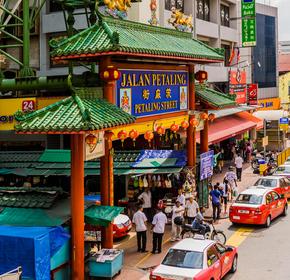
Kuala Lumpur travel guide
Kuala Lumpur Tourism | Kuala Lumpur Guide
You're Going to Love Kuala Lumpur
Known as "KL", Kuala Lumpur is the capital city of Malaysia and home to the famous Petronas Twin Towers. A self-contained city that celebrates its modern present while still honoring its distinctly Southeast Asian heritage, Kuala Lumpur's frenetic urban pace is set against a stunning backdrop; you can soak it all up at flea markets, food centers and roadside stalls, lush surrounding highlands, and shimmering waterfronts.
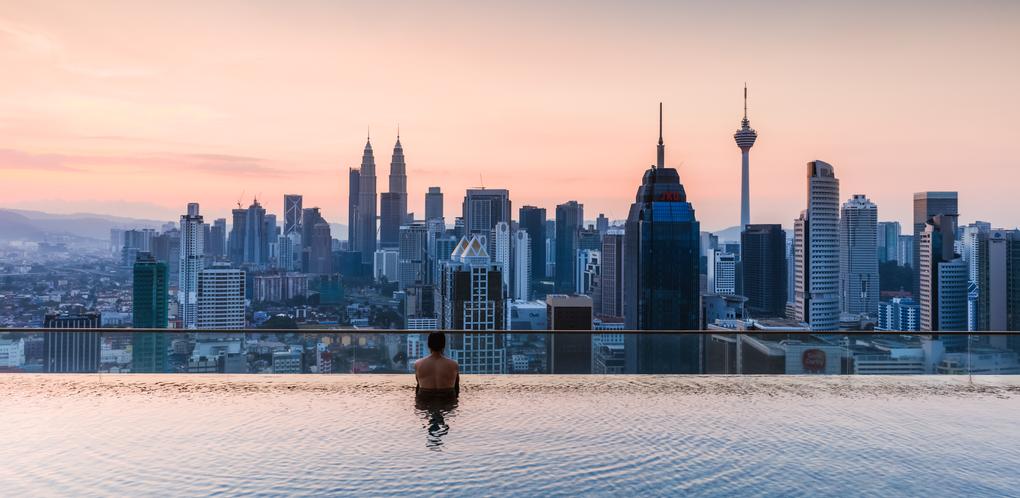
Kuala Lumpur is best experienced on a bike or by foot. From every corner wafts the aroma of authentic Malaysian, Singaporean, and Southeast Asian delicacies, which provide ample fuel for sightseeing.
Chinatown exists alongside the Kopitiams (traditional coffee shops) of the Malay tradition while the centerpiece of the show, Pavilion Kuala Lumpur, is a commercial haven for shoppers from all corners of the world.
Top 5 Reasons to Visit Kuala Lumpur
1. Take a Tour
The best way to take it all in is to embark on one of the many tours offered by the city. The half day Batu Caves Tour spans three hours and takes you to the 400-million-year-old caves outside the city. Alternatively, book a spot on the KL Private Night Heritage Trails that take you to pre-war temples and perfectly preserved historical streets.
2. Shop Till You Drop
Every shopper's dream, Kuala Lumpur has commercial hubs and dazzling malls for those who love brands. The Pavilion is a prime location for this, with over 450 stores at the heart of the Bukit Bintang district. Take a walk along the streets of Kuala Lumpur for street vendors hawking their wares at bargain prices.
3. Citylicious
If sampling your way through a smorgasbord of affordable Southeast Asian cuisine is on your bucket list, Kuala Lumpur is the place to do it. Chow down on comforting congee for RM9.90, or tuck into a classic Madras thali (a little bit of everything vegetarian!) for just RM9.90.
4. A Towering Viewpoint
At the base of the Petronas towers is Suria KLCC or "Kuala Lumpur City Centre", which is described as a city within a city. If the sheer height of the towers doesn't send you spinning, the Suria KLCC will: it's divided into three separate sections, Ampang Mall, KLCC Park Mall, and Ramlee Mall. There are tons of upmarket brands and luxury labels such as Dior and more mid-range stores like Pierre Cardin.
5. Get Lost in Jalan Alor
Tucked away behind Jalan Bukit Bintang stands Jalan Alor, a veritable maze of food stalls and vendors. This is where the night-wanderers, after-hours clubbers, migrant workers, and tourists throng for cheap eats, bright lights, and a lively atmosphere.
What to do in Kuala Lumpur
1. Petronas Towers: Twinning
Icons of Southeast Asia, these feats of construction are recognized the world over. The futuristic design takes over the skyline, two identical giants towering over the city. Connecting the 41st floors, a slim sky bridge is the most thrilling attraction here. For even better views travel to the 86th floor! Or, if you prefer to stay grounded, the entertainment never ends - even at street level. Suria KLCC Shopping Mall is one of the most luxurious in the world, and the park outside offers recreation for all ages.
2. Batu Caves: So Much to See
Not far from the city center, these natural limestone caves are awe-inspiring to everyone who explores within. A Hindu temple is set inside the mystical labyrinth, so integrated that it's hard to tell where human-made structures begin and the natural world takes over. Greeting visitors to the site is the enormous golden statue of Murugan, inviting all to climb the 272 steps where views of the city await. Monkeys frolic all over the mountain, adding to the delight of the experience.
3. Merdeka Square: Where It All Began
In 1957 Malaysia's flag was hoisted for the first time in this square, and the banner still billows here at over 300 feet today. Surrounding the base of the symbolic flagpole are perfectly manicured fields providing an open space at the heart of Kuala Lumpur's colonial center. This is where National Day is celebrated every year with the Merdeka Parade, and historical sights abound year round. Visit the Sultan Abdul Samad Building in particular for political insight into Malaysia's history.
4. Perdana Botanical Gardens: Lakes and Flourishing Land
Surrounded by the ever bustling metropolis of Kuala Lumpur, these gardens were designed during the colonial era to offer a respite from the ever-growing city. They continue to succeed in offering rest and recreation to all who come calling - with never-ending gardens, serene walking trails, refreshing water features and many plant species that you've never encountered before; the enjoyment doesn't end. Don't miss the colorful Orchid Garden or Butterfly Park either!
5. Chinatown: Shop 'til You Drop
As in most world cities, Kuala Lumpur's Chinatown is as colorful as it is cultural - a must-see neighborhood. Petaling Street is the primary thoroughfare of this thrilling area, full of restaurants and sights by day and teeming with market stalls by night. This is a bargain hunter's haven with the widest variety of goods imaginable being sold at the cheapest prices, especially after a bit of good spirited haggling. For a unique cultural stop along the way, visit Sri Mahamariamman Temple.

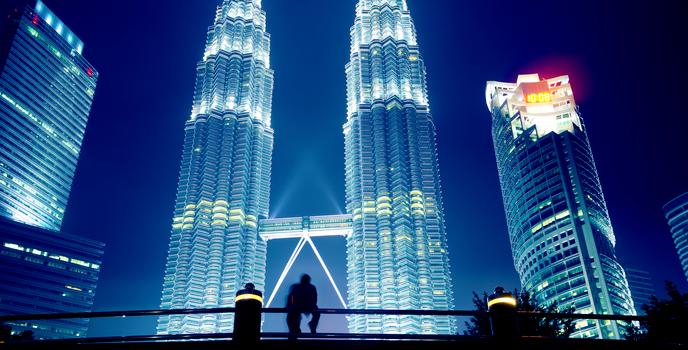
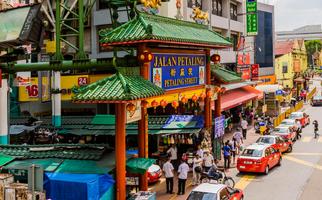
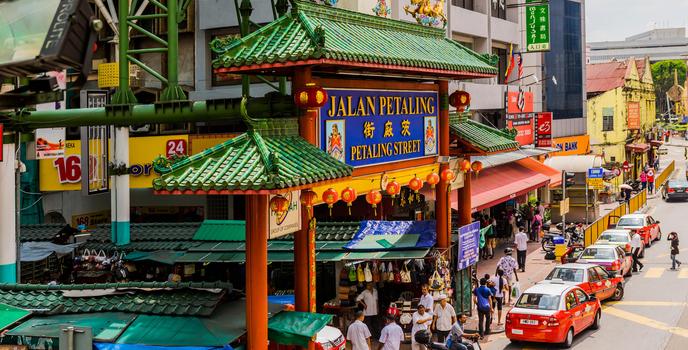
1. Petronas Towers: Twinning
Icons of Southeast Asia, these feats of construction are recognized the world over. The futuristic design takes over the skyline, two identical giants towering over the city. Connecting the 41st floors, a slim sky bridge is the most thrilling attraction here. For even better views travel to the 86th floor! Or, if you prefer to stay grounded, the entertainment never ends - even at street level. Suria KLCC Shopping Mall is one of the most luxurious in the world, and the park outside offers recreation for all ages.
2. Batu Caves: So Much to See
Not far from the city center, these natural limestone caves are awe-inspiring to everyone who explores within. A Hindu temple is set inside the mystical labyrinth, so integrated that it's hard to tell where human-made structures begin and the natural world takes over. Greeting visitors to the site is the enormous golden statue of Murugan, inviting all to climb the 272 steps where views of the city await. Monkeys frolic all over the mountain, adding to the delight of the experience.
3. Merdeka Square: Where It All Began
In 1957 Malaysia's flag was hoisted for the first time in this square, and the banner still billows here at over 300 feet today. Surrounding the base of the symbolic flagpole are perfectly manicured fields providing an open space at the heart of Kuala Lumpur's colonial center. This is where National Day is celebrated every year with the Merdeka Parade, and historical sights abound year round. Visit the Sultan Abdul Samad Building in particular for political insight into Malaysia's history.
4. Perdana Botanical Gardens: Lakes and Flourishing Land
Surrounded by the ever bustling metropolis of Kuala Lumpur, these gardens were designed during the colonial era to offer a respite from the ever-growing city. They continue to succeed in offering rest and recreation to all who come calling - with never-ending gardens, serene walking trails, refreshing water features and many plant species that you've never encountered before; the enjoyment doesn't end. Don't miss the colorful Orchid Garden or Butterfly Park either!
5. Chinatown: Shop 'til You Drop
As in most world cities, Kuala Lumpur's Chinatown is as colorful as it is cultural - a must-see neighborhood. Petaling Street is the primary thoroughfare of this thrilling area, full of restaurants and sights by day and teeming with market stalls by night. This is a bargain hunter's haven with the widest variety of goods imaginable being sold at the cheapest prices, especially after a bit of good spirited haggling. For a unique cultural stop along the way, visit Sri Mahamariamman Temple.




Where to Eat in Kuala Lumpur
If you wind your way around Jalan Alor, you'll find numerous food stalls serving up authentic Pad Thai, Mee Goreng, Congee, Ramen, and Madra Thalis. Food stall prices will rarely go over RM10 for a single meal. Head to upscale dining spots like Marini's On 57, where you can expect to spend at least RM250-300 for two. Indulge in the charm of local cafes like Humble Chef where fried laksa and spaghetti will run you just RM5.
When to visit Kuala Lumpur
Kuala Lumpur's maritime climate remains mostly unchanged all year round. While the city's heat and humidity are certainly tempered by the rains, temperatures range from 69 degrees Fahrenheit to 91 degrees Fahrenheit. Usually, tourists try and avoid the wetter season, which spans from March to April and September to November.
How to Get to Kuala Lumpur
Plane
Kuala Lumpur's main airport is about 31 miles southwest of the city. It is known as the Kuala Lumpur International Airport (KUL), is a hub for international and domestic flights, and is located in the Sepang district of Selangor. Once travelers arrive, they can take the KLIA Ekspres trains that link the Main Terminal with the KL Sentral hub in Kuala Lumpur. These direct trains cost RM55 and take around 55 minutes to reach the city center. Journeys by bus are usually handled by Airport Coach and Star Shuttle; these cost RM11 and RM12, respectively.
Train
Kuala Lumpur enjoys direct land access to several of its city and country neighbors like Johor Bahru, Penang, Langkawi, as well as Singapore and Krabi, Thailand. KL Sentral, located in Brickfields, is where all cross-country and international trains arrive and depart. There are day and overnight trains that come from Singapore, Hat Yai, and Kota Bharu. Travelers can take the Train 24 overnight sleeper trains from Singapore; the journey to Kuala Lumpur is seven hours.
Car
Since the main hub of Malaysia is Kuala Lumpur, many of the main highways lead to and go from the city itself. Through the heart of the city runs the North-South Expressway (E1 & E2) that stretches from the Malaysia-Thailand border and connects to Singapore via Johor Bahru. Once on the highway, the main exits for Kuala Lumpur on the expressway are Jalan Duta when coming from the north, and, from the south, Sungai Besi.
Bus
For long distance travel into and out of the city, Kuala Lumpur has many bus terminals that service multiple areas. Buses coming in from Ipoh, Butterworth, or Thailand arrive at either Pudu Sentral or Terminal Bersepadu Selatan (TBS, for short). If you're traveling from Hat Yai, Thailand, for example, the cost is RM55 one way.
Airlines serving Kuala Lumpur
Where to stay in Kuala Lumpur
Bukit Bintang - even though traffic flows are heavy in Bukit Bintang, you can always move around with ease on foot. This district is a must-see when you're in Kuala Lumpur. Trendy and teeming with nightlife, the streets of Bukit Bintang offer the best in shopping alongside an indoor amusement park at Berjaya Times Square, pubs like Hemingway's, and nightclubs like Little Havana.
Popular Neighborhoods in Kuala Lumpur
Chinatown - for those who want to be centrally located but also want to experience the rich history of Kuala Lumpur, this is the ideal neighborhood. It's packed with backpackers' inns and is a prime spot for bargain hunters and food stall lovers.
KL Sentral - perfect for business people, KL Sentral is home to many international companies, eateries, and malls. The best part about KL Sentral is its proximity to places like Little India or to famous Buddhist temples.
Where to stay in popular areas of Kuala Lumpur
Most booked hotels in Kuala Lumpur
How to Get Around Kuala Lumpur
Public Transportation
The city is serviced by a combination of bus, train, and monorail. There is a range of services such as LRT (Light Rail Transit), KTM Komuter for trains, and the bus companies Go KL, Rapid KL, and a double-decker hop-on hop-off sightseeing tour bus for tourists. Visitors to Kuala Lumpur have two options: they can purchase a MyRapid card for RM20, which is valid on all Rapid KL buses as well as the monorail and LRT lines. It can be purchased at any monorail and LRT station. The second option is to buy a Touch 'n Go Card, which can be used on public transit in the Klang Valley as well as at highway tollbooths around Malaysia and even select parking spots. It costs just RM10.60 and can be recharged up to RM500. Purchase one at KL Sentral station or the KLCC LRT Station.
Taxi
Kuala Lumpur is serviced by red and white taxis that cost RM5 for the first mile and then RM1.6 per mile thereafter. If you see bright blue executive taxis, these are RM9.6 for the first mile and then RM3.2 per mile. Expect a per-use service charge for amenities like radio calls and baggage. In general, stick to public transport, traveling by foot, or ridesharing apps like Uber and GrabCar as these are cheaper and much less complicated than regular taxis.
Car
This is pretty much only recommended if you have a good command of the local language and knowledge of traveling in the region. Car rentals are available starting from RM150 per day, and you'll find Hertz and Europcar outlets in town. While the streets are superbly maintained in Kuala Lumpur, traffic, coupled with scooters, pedestrians, and the use of tolls during rush hour make a car a non-economic way to travel.
The Cost of Living in Kuala Lumpur
Shopping Streets
Without a doubt, the main shopping and entertainment district for travelers of all stripes is Bukit Bintang with the pièce de resistance, the Pavilion Kuala Lumpur. With 550 retail outlets and restaurants, the Pavilion is the perfect place to spend the day shopping for clothing, trendy backpacks, and eyewear, before settling down to a delicious meal at Al Halabi Gourmet Restaurant. At Suria KLCC, you can take in a movie at the cinema and check out the water creatures at the Aquaria KLCC as you shop for luxury goods.
Groceries and Other
Living in Kuala Lumpur can be quite economical if you know how to make your money stretch and set a budget each month. The Intermark Mall is a centrally located spot for international grocers. Typically, rice costs RM6 and a dozen eggs will run at RM12.

